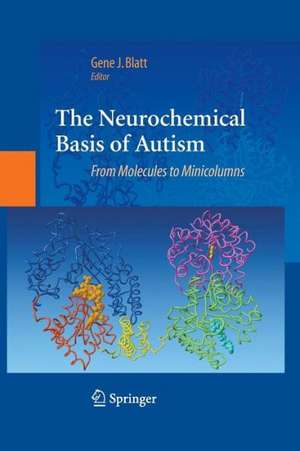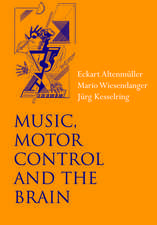The Neurochemical Basis of Autism: From Molecules to Minicolumns
Editat de Gene J. Blatten Limba Engleză Paperback – 12 dec 2014
| Toate formatele și edițiile | Preț | Express |
|---|---|---|
| Paperback (1) | 945.30 lei 6-8 săpt. | |
| Springer Us – 12 dec 2014 | 945.30 lei 6-8 săpt. | |
| Hardback (1) | 949.73 lei 6-8 săpt. | |
| Springer Us – 13 dec 2009 | 949.73 lei 6-8 săpt. |
Preț: 945.30 lei
Preț vechi: 1152.81 lei
-18% Nou
Puncte Express: 1418
Preț estimativ în valută:
180.91€ • 187.27$ • 152.91£
180.91€ • 187.27$ • 152.91£
Carte tipărită la comandă
Livrare economică 06-20 martie
Preluare comenzi: 021 569.72.76
Specificații
ISBN-13: 9781489981974
ISBN-10: 1489981977
Pagini: 312
Ilustrații: XV, 295 p.
Dimensiuni: 155 x 235 x 16 mm
Greutate: 0.44 kg
Ediția:2010
Editura: Springer Us
Colecția Springer
Locul publicării:New York, NY, United States
ISBN-10: 1489981977
Pagini: 312
Ilustrații: XV, 295 p.
Dimensiuni: 155 x 235 x 16 mm
Greutate: 0.44 kg
Ediția:2010
Editura: Springer Us
Colecția Springer
Locul publicării:New York, NY, United States
Public țintă
ResearchCuprins
Autism Spectrum Disorders: Clinical and Medical Perspectives.- The Male Prevalence in Autism Spectrum Disorders: Hypotheses on its Neurobiological Basis.- Neuroanatomical-Behavioral Correlates in Autism: A Working Hypothesis.- The Morphology of Minicolumns.- The Developmental Neuropathology of Autism.- Understanding Alterations During Human Brain Development with Molecular Imaging: Role in Determining Serotonin and GABA Mechanisms in Autism.- Glutamic Acid Decarboxylase (GAD) as a Biomarker of GABAergic Activity in Autism: Impact on Cerebellar Circuitry and Function.- Epigenetic Dysregulation of 15q11-13 GABAA Receptor Genes in Autism.- Cholinergic Component of Autism Spectrum Disorder.- Oxytocin and Autism.- The Role of the Noradrenergic System in Autism Spectrum Disorders.- Oxidative Stress in Autism and Its Implications for Dopamine-Stimulated Phospholipid Methylation.- Neuroligins and Neurexins: Synaptic Bridges Implicated in Autism.- The Neurophysical Chemistry of Autism: Postulates from Intelligence Modeling.- Pharmacological Treatment of Autism.
Recenzii
From the reviews:“In this much needed book aimed at researchers, scientists and clinicians, Blatt (anatomy and neurobiology, Boston U) assembles 15 chapters that focus on the neurochemical basis of autism a little studied topic. … Lay abstracts and summaries at the end are aimed at parents, siblings and caregivers.” (SciTech Book News, June, 2010)
Textul de pe ultima copertă
The recent perceived rise in autism worldwide has spurned a dramatic increase in autism research, but few studies have focused on determining the neurochemical basis of the disorder. The Neurochemical Basis of Autism: From Molecules to Minicolumns is a uniquely vital and interdisciplinary text that presents the latest findings and newest ideas regarding the physiological, neuropathological, neurochemical and clinical elements of autism.
This book contains an array of unique perspectives on autism from top researchers in their respective fields. It begins with a clinical and medical perspective that discusses etiologies, early identification, advancements in medical care and associated disorders. It then proceeds to cover a variety of topics such as neuropathological changes in autism to the pre- and post-natal development timing of the disorder, changes in the cerebellum in autism, the role of oxytocin in autism, the relationship of oxidative stress and autism, a comprehensive review of pharmacotherapies, and much more. Lastly, the book recounts the novel hypotheses being used to explore the causes and cures of the disorder.
Chapter introductions and lay abstracts make this book as accessible to the parents, siblings and caretakers of autistic children as it is indispensable to the scientists, researchers and clinicians on the front line of this baffling affliction.
About the Editor
Dr. Gene J. Blatt is currently an Associate Professor in the Department of Anatomy and Neurobiology at Boston University School of Medicine. He received his Ph.D. specializing in Neuroanatomy at Thomas Jefferson University in Philadelphia. For the past 10 years, Dr. Blatt’s research interests have focused on the neuropathological and neurochemical basis of autism, utilizing cerebellar, limbic and cerebral cortical human postmortem tissue and he has published extensively in these areas. A specific focus has been on the GABA system in autism and Dr. Blatt was one of the first researchers to demonstrate GABAergic abnormalities in the autism brain.
This book contains an array of unique perspectives on autism from top researchers in their respective fields. It begins with a clinical and medical perspective that discusses etiologies, early identification, advancements in medical care and associated disorders. It then proceeds to cover a variety of topics such as neuropathological changes in autism to the pre- and post-natal development timing of the disorder, changes in the cerebellum in autism, the role of oxytocin in autism, the relationship of oxidative stress and autism, a comprehensive review of pharmacotherapies, and much more. Lastly, the book recounts the novel hypotheses being used to explore the causes and cures of the disorder.
Chapter introductions and lay abstracts make this book as accessible to the parents, siblings and caretakers of autistic children as it is indispensable to the scientists, researchers and clinicians on the front line of this baffling affliction.
About the Editor
Dr. Gene J. Blatt is currently an Associate Professor in the Department of Anatomy and Neurobiology at Boston University School of Medicine. He received his Ph.D. specializing in Neuroanatomy at Thomas Jefferson University in Philadelphia. For the past 10 years, Dr. Blatt’s research interests have focused on the neuropathological and neurochemical basis of autism, utilizing cerebellar, limbic and cerebral cortical human postmortem tissue and he has published extensively in these areas. A specific focus has been on the GABA system in autism and Dr. Blatt was one of the first researchers to demonstrate GABAergic abnormalities in the autism brain.
Caracteristici
Includes supplementary material: sn.pub/extras















